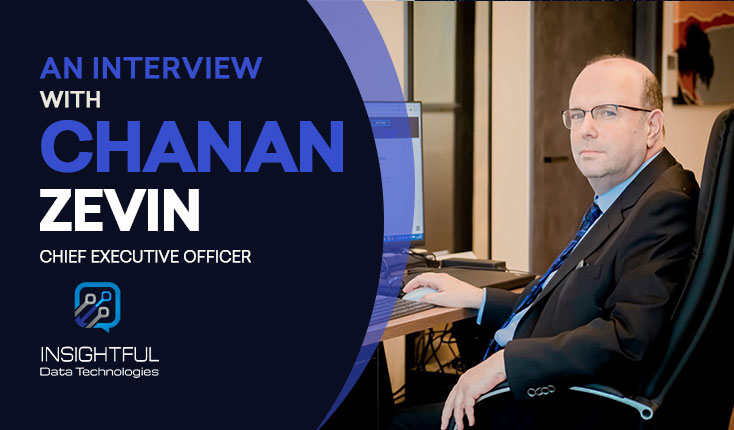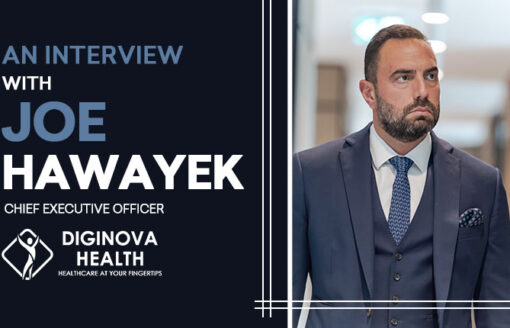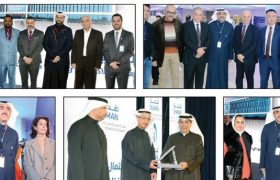We had the honor of sitting down with Chanan Zevin, the CEO and Founder of Insightful Data Technologies – FZCO. Chanan’s remarkable journey, from his skill development and gaining practical knowledge to his current role as CEO, is truly inspirational. In this candid interview, Chanan delves into his career path, the impact of education, the unwavering support of his parents, his adaptable and flexible approach, and his perspective on the importance of continuous learning.
Insightful Data Technologies – FZCO is a company specializing in the conversion of complex data into powerful insights, with a primary focus on forex forecasting. Chanan Zevin actively shapes the brand’s identity and works towards expanding its global presence. His insights on continuous learning, the value of a cross-functional team, and his dedication to prioritizing clients and employees provide valuable lessons for aspiring professionals in this field.
Elevating Complexity

We started the interview by asking, “Can you share examples of projects where you successfully transformed complex data into insightful, data-driven solutions?”
Chanan shared, “Our team developed an advanced trading algorithm that utilized predictive analytics to decipher market trends and anticipate potential price movements in currencies. This algorithm proved its efficacy by showcasing an exceptional ability to yield approximately 15% returns within just 5 investment days. But it’s not just about the predictive capability. An interactive dashboard complements our solution. It allows users to effortlessly tweak input parameters, tailoring investment strategies to suit their risk appetite and market understanding. The dashboard highlights various trading avenues, elucidating each month’s vast profit potential. Such a comprehensive tool not only aids in making informed decisions but also grants users a holistic understanding of the financial market dynamics. Understanding the Foreign Exchange market volatility is crucial, given its potential implications on global trade and investments. We designed a comprehensive tool aimed at assessing FX rates’ volatility. Here’s what our solution offers: Measurement of Change: Our tool quantifies value fluctuations within specified periods. This numerical representation becomes instrumental in predicting future trends and grasping associated risks. Risk Evaluation: The tool identifies high volatility zones, signaling heightened risk. It helps users discern the potential challenges of rapid value changes and strategize accordingly. Market Understanding: Our volatility assessment offers insights into market behavior, especially for investors and traders. Whether capitalizing on the opportunities presented by high volatility or understanding the stable landscape of low volatility, our tool guides users in navigating these waters effectively. Informed Decision-making: Using our tool, businesses can make data-driven decisions. For instance, should FX rates be exceptionally volatile, they could adopt hedging strategies to curtail potential currency exposure risks. Scenario Planning: By analyzing historical volatility patterns, our tool assists experts in framing scenarios and predicting future trajectories. This is essential for effective contingency planning and staying prepared for market shifts.
Effective Use of Financial Products: Our tool aids in proficiently using financial derivatives like options, ensuring they’re priced and leveraged aptly for optimal risk management. Both these projects underscore our commitment to transforming intricate data into actionable insights. We believe in the power of data-driven decision-making and strive to equip our users with the best tools to navigate the often-turbulent waters of the financial world.
Netanel Zevin’s Approach to Emerging Technologies

Then we asked, “How do you keep up with the rapidly advancing technologies in the data science field, as mentioned by Netanel Zevin?”
He shared, “Staying abreast of the evolving landscape of data science is indeed a challenge, but it’s one that we embrace wholeheartedly. As per the insights shared by Netanel Zevin, our approach to continuous learning and adaptation revolves around the following strategies:
1.We have set up specialized R&D teams whose sole focus is to keep an eye on emerging technologies, techniques, and best practices in the data science realm. This proactive approach ensures that we are always at the forefront of innovation.
2. We invest heavily in the professional development of our team members. Regular workshops, seminars, and courses are organized to keep our staff updated with the latest methodologies and tools Attending international data science conferences and forums facilitates direct interactions with industry pioneers and thought leaders. These platforms offer insights into upcoming trends and the field’s direction. We actively collaborate with academic institutions, research bodies, and tech startups. These partnerships allow us to tap into a broader pool of knowledge and stay updated with breakthroughs in the industry. Within our organization, we promote a culture of knowledge exchange. Regular internal meet ups and sessions are organized where team members share their learning’s, experiences, and discoveries. In terms of operations, we employ agile frameworks that support the rapid integration of new technologies and methodologies. This ensures that our projects always leverage the best and most recent tools available. Ultimately, the choice of technique depends on your data, the problem you’re trying to solve, and the trade-offs between model complexity, interpretability, and performance.”
Best Practices for Ensuring Security and Privacy

Then we asked, “What are some best practices you follow to maintain data security and privacy when working with financial data in your products?”
He answered, “The security and privacy of financial data is of paramount importance for our products. We understand the sensitivity of this information and the potential risks that can arise if it’s not handled correctly. Here are some best practices we follow to ensure data security and privacy: All financial data is encrypted in transit and at rest. We use advanced encryption protocols to protect data from unauthorized access or interception. We conduct regular security audits and vulnerability assessments to identify and address potential risks and weaknesses in our systems. When processing or analyzing financial data, we employ data anonymization and masking techniques to protect individuals’ personal and sensitive information. Financial data is stored in secure, state-of-the-art data centers with multiple layers of physical and digital security measures in place We enforce strict access controls to ensure only authorized personnel can access financial data. This is monitored and audited regularly. Our employees receive ongoing training on data security and privacy best practices. They know the potential risks and their responsibilities in protecting financial data. We adhere to all relevant data protection and privacy regulations, such as GDPR, HIPAA, and others that apply to the financial industry. We have a robust incident response plan to promptly address any potential data breaches or security incidents. We employ two-factor authentication for accessing financial data to add an extra layer of security. We have clear policies for data retention and disposal to ensure that financial data is not stored longer than necessary and is securely disposed of when no longer required.”
Analytical Techniques Unveiled
We want to know the difference in Comparing Linear Regression, Logistic Regression, and Decision Trees so we asked, “Could you explain the differences between various analytical techniques you’ve mentioned, such as linear regression, logistic regression, and decision trees? When would you use one over the other?”
Chanan shared, “Linear Regression: Linear regression models the relationship between a dependent variable (usually continuous) and one or more independent variables (predictors). It assumes a linear relationship between the variables, meaning that the change in the dependent variable is proportional to changes in the independent variables. Linear regression is commonly used for predicting house prices based on features like square footage, number of bedrooms, and location. It is unsuitable for classification tasks or situations where the dependent variable is binary or categorical. Logistic Regression: Logistic regression is used for binary classification problems, where the dependent variable is categorical with two classes (e.g., yes/no, spam/ham, etc.). It models the probability that an observation belongs to a particular class as a function of one or more independent variables. Logistic regression uses the logistic function (sigmoid) to transform the output into a probability between 0 and 1. It’s commonly used in applications like fraud detection, medical diagnosis, and sentiment analysis, where you must make binary decisions. Decision Trees: Decision trees are versatile and can be used for classification and regression tasks. They work by recursively splitting the data into subsets based on the values of input features. Decision trees make decisions by following a path from the root node to a leaf node, where each internal node represents a decision or a split based on a feature. They are interpretable and can handle both categorical and numerical data. Decision trees are helpful when you want to capture complex relationships between features or need an interpretable model. However, they can only benefit from overfitting if appropriately pruned. When to use one over the other depends on the nature of your problem: Use linear regression when you have a continuous dependent variable and want to model linear relationships between variables. Use logistic regression when you have a binary classification problem and must estimate class membership probabilities. Use decision trees when you need a model that can handle classification and regression tasks; interpretability is essential. Decision trees can also be used in ensemble methods like Random Forests or Gradient Boosting to improve predictive performance.”
Extracting Insights from Real-World Data Challenges
AI and Machine Learning in Action in today’s world so we asked, “What are some real-world applications where you’ve used AI and Machine Learning to extract valuable insights from complex datasets?”
Chanan shared, “Over the years, AI and Machine Learning have been instrumental in various sectors by allowing us to derive actionable insights from intricate datasets. Here are some notable applications where these technologies have made significant impacts:
Financial Trading Algorithms:
Description: Developed sophisticated trading algorithms to analyze market trends and predict potential price movements in currencies
Outcome: Harnessing advanced predictive analytics, the algorithm demonstrated impressive returns on investments, optimizing trading strategies based on live market conditions.
Customer Churn Prediction:
Description: Analyzed customers’ transactional, behavioral, and demographic data in a telecom company to predict which customers are most likely to churn. Outcome: The insights allowed the company to design targeted retention campaigns, significantly reducing customer attrition and improving customer lifetime value.
Healthcare Diagnostic Tools:
Description: Leveraged machine learning algorithms to analyze medical imaging data to detect early signs of diseases like cancer. Outcome: Achieved a high accuracy rate, enabling timely interventions and treatments, potentially saving lives. Supply Chain Optimization: Description: Used AI to forecast product demand, helping businesses optimizes inventory levels and reduces stock outs or overstock scenarios. Outcome: Resulted in improved operational efficiency, reduced costs, and enhanced customer satisfaction due to the timely availability of products.
Sentiment Analysis on social media:
Description: Processed vast amounts of textual data from social media platforms to gauge public sentiment on specific topics, products, or services. Outcome: Businesses could promptly adjust their marketing strategies, address customer concerns, and capitalize on positive feedback.
Smart Energy Management: Description: Utilized machine learning models to predict energy consumption patterns based on historical data and real-time usage metrics. Outcome: Energy providers could manage their grids more efficiently, and consumers benefited from personalized energy-saving recommendations. Fraud Detection in Banking:
Description: Implemented AI models to analyze transactional patterns and flag anomalous activities, indicating potential fraud. Outcome: Enhanced security for banking clients, with a notable reduction in unauthorized transactions and improved trust in digital banking platforms.”
Cracking the Data Limitation Challenge

Get to know the Building Predictive Models with Scarce Data, “How would you approach building a predictive model for a problem with limited data availability?
Chanan shared, “When confronted with limited data, constructing an effective predictive model poses unique challenges. However, there are several strategies we can employ to maximize the utility of the data at hand: 1. Simplifying the Model: Complex models with many parameters, like deep neural networks, require vast data. In scenarios with limited data, it’s advisable to use simpler models such as linear or logistic regression. These models are less likely to overfit and can often provide decent performance on small datasets. 2. Feature Engineering: Given the constraint on the number of data points, we can focus on extracting the most relevant information from our features. This involves creating new features, transforming existing ones, and identifying which are most pertinent to the prediction task. Techniques like L1 (Lasso) and L2 (Ridge) regularization can prevent over fitting in models by penalizing significant coefficients or keeping them sparse. Regularization can be particularly beneficial when we have fewer data points. By creating multiple subsets of the data through techniques like bootstrapping, we can train the model on different data combinations, improving its generalization.”
Can you describe a project where you worked with big data technologies like Hive, Hadoop, and Spark? “What challenges did you encounter, and how did you address them?”
Chanan shared, “ Project Description: Let’s consider a project for a large e-commerce company that wants to analyze and extract valuable insights from their vast amount of customer data, which includes transaction history, clickstream data, and customer behavior on their website.
Technologies Used:
- Hadoop: The project starts by utilizing Hadoop for distributed storage and batch processing of the vast amount of raw data. Hadoop’s HDFS (Hadoop Distributed File System) stores the data in a fault-tolerant and distributed manner, making it suitable for handling massive datasets.
2. Hive: To enable SQL-like querying on the structured data within Hadoop, Hive is used to create tables and run queries using the Hive Query Language (HQL). This allows data analysts and scientists to access and manipulate the data efficiently. 3. Spark: As the project progresses, Spark are introduced to perform real-time and batch-processing tasks efficiently. It is used for machine learning, data streaming, and complex transformations. Spark’s ability to cache data in memory can significantly improve processing speed.
Challenges and Solutions:
- Data Volume: One of the significant challenges is dealing with the massive volume of data. Hadoop’s distributed storage helps address this by storing the data across multiple nodes, while Spark’s distributed computing capabilities ensure efficient data processing.
- Data Variety: Customer data can come in various formats, including structured, semi-structured, and unstructured. Hive’s ability to define schemas for structured data and process semi-structured data using Hive SerDes (Serializer/Reserialize) can help address this challenge.
- Data Latency: Real-time insights are crucial for quick business decisions. Spark’s real-time processing of streaming data can help reduce data latency and enable faster decision-making.
- Resource Management: Managing resources efficiently in a distributed environment is critical. Tools like Apache YARN can be used for resource allocation and management to ensure that jobs are executed smoothly without resource bottlenecks.
- Scalability: As the company’s data grows, it’s essential to ensure that the big data infrastructure can scale horizontally. This might involve adding more nodes to the Hadoop cluster or optimizing Spark jobs for better performance.
- Data Quality: Maintaining data quality throughout the process is essential. To address this challenge, data validation, and cleansing steps should be implemented in batch and real-time processing pipelines.
- Security: Protecting sensitive customer data is a top priority. Implementing security measures like authentication, authorization, and encryption for data at rest and in transit is crucial to ensure data privacy and compliance with regulations.
In summary, working with big data technologies like Hive, Hadoop, and Spark in a project involves addressing data volume, variety, latency, resource management, scalability, data quality, and security challenges. Each challenge requires careful planning, implementation, and ongoing maintenance to extract valuable insights from large datasets while ensuring data integrity and security.
Data Integrity in Diverse Sources

We were Ensuring Quality and Consistency in Data Pipelines so we further asked, “How do you ensure data quality and consistency in data pipelines, especially when dealing with large and diverse data sources?”
Chanan replied, “Data quality and consistency is paramount, especially when working with large and diverse datasets. Here are the steps and best practices I follow to maintain high data quality in our pipelines:
1. Data Validation at Source: Before any data ingestion, validating the data at its source is crucial. We implement checks to ensure that the data meets specific criteria or constraints, ensuring that only high-quality data enters the pipeline.
2. Automated Data Quality Checks: Automated quality checks are run at various pipeline stages once data is ingested. These checks can identify missing values, outliers, or other anomalies that might indicate data quality issues
3. Data Profiling: Periodic data profiling helps understand the data’s distribution and characteristics. It aids in identifying any anomalies or shifts in the data that might go unnoticed with standard quality checks.
4. Consistency Checks: It’s essential to check for consistency, especially when integrating multiple data sources. For instance, ensuring that data formats, units of measurement, or encoding standards are consistent across sources.
5. Logging and Monitoring: Implement robust logging mechanisms within the pipeline. Any anomalies, failures, or rejections should be logged and monitored. Automated alerts notify relevant teams of any issues, allowing for swift action.
6. Data Versioning: Similar to code versioning, data versioning ensures that you can roll back to previous datasets if needed. This is particularly useful if a data quality issue is identified after processing data.
7. Regular Data Audits: Periodic manual reviews and audits of the data and the pipeline processes help identify issues that automated checks might not catch.
8. Feedback Loop: Establish a feedback loop with the end-users of the data. Often, they can provide insights into inconsistencies or quality issues based on their hands-on experience with the data.
9. Metadata Management: Maintain a metadata repository that provides details about data lineage, transformations applied, source information, and other essential details. This aids in transparency and clarifies the data’s journey through the pipeline.
10. Continuous Training and Education: The world of data is ever-evolving. Regular training sessions for the data team ensure they are up to date with the latest best practices and tools to maintain data quality.
Product Impact Stories
We further asked, “Can you share any specific examples of how your products, like Forex Predictions or the Interactive Dashboard, have provided value to clients or businesses?”
He replied, “Our products, including Forex Predictions and the Interactive Dashboard, have played a pivotal role in revolutionizing how businesses approach their operations, especially in Forex trading. A standout example of this was our collaboration with one of the world’s largest banks:
Risk Management for the World’s Leading Bank: When this banking giant approached us, they grappled with intricate challenges in their Forex trading room. They sought a robust solution to enhance their risk management protocols and fortify their trading strategies.
Here’s how our products made a difference:
1. Tailored Forex Predictions: Leveraging our predictive algorithm, the bank could anticipate potential currency fluctuations with a higher degree of accuracy. This predictive power meant they could make more informed decisions on when to buy or sell, reducing the chances of adverse market movements impacting their bottom line.
2. Interactive Dashboard Integration: Our dashboard became an integral part of the bank’s trading room. Its interactivity allowed traders to swiftly adjust input parameters based on real-time data, thereby adapting to market shifts instantaneously. The dashboard’s intuitive design facilitated quicker decision-making, minimizing reaction times and enhancing overall trading efficiency.
3. Holistic Risk Management: Beyond just predictions, our tools provided a comprehensive assessment of market volatility. The bank’s trading strategies became more dynamic, allowing it to mitigate risks in highly volatile conditions and capitalize on opportunities in more stable markets.
4. Empowering Decision Makers: Senior executives and decision-makers in the bank had access to distilled, actionable insights from vast data sets, thanks to our tools. This meant they could craft overarching strategies and guidelines for their trading teams, fostering a cohesive approach to Forex trading across the institution.
5. Scalable Solutions for Growth: Given the bank’s global presence, our products’ scalability ensured that multiple trading rooms across different regions benefited from a uniform, high-quality risk management system. This uniformity was key in promoting best practices and maintaining consistency in trading operations worldwide.
In conclusion, our collaboration with this leading global bank underscores the transformative potential of our products. By building their entire Forex trading room’s risk management around our solutions, the bank fortified its defenses against unpredictable market movements and set a gold standard for other financial institutions worldwide
A Competitive Edge for Clients
Then we asked, “In what ways does your company’s speed of implementation, as mentioned, benefit clients? Can you provide an example where this speed was crucial in a project’s success?”
He replied, “Absolutely, speed of implementation is a hallmark of our company and has proven invaluable for our clients time and again. In the fast-paced world of finance and technology, the ability to swiftly deploy solutions can be the difference between capitalizing on an opportunity and missing it altogether. One of the primary benefits our clients receive from our rapid implementation is the agility it grants them. Financial markets and business landscapes evolve constantly, and waiting weeks or months for a solution can often render it obsolete upon arrival. By implementing our solutions swiftly, we ensure that our clients have the tools they need when they need them, allowing them to stay ahead of the curve and adapt to changing circumstances. For example, in a recent collaboration with one of the world’s largest banks, we were approached to design and implement a risk management system for their forex trading room. Given the massive daily trading volumes and the volatility of the forex markets, any delay in implementing the system could have resulted in substantial financial losses and missed opportunities for the bank. Our team, drawing upon its extensive experience and acumen, was able to design, test, and deploy the system in record time, safeguarding the bank’s assets and positioning them to capitalize on favorable market movements. Furthermore, our focus on cutting through the noise and avoiding unnecessary distractions means that our solutions are not only implemented quickly but are also laser-focused on addressing the core challenges our clients face. We believe in the principle of doing more with less, and by concentrating on essential functionalities and employing efficient methodologies, we’ve consistently delivered robust solutions in impressively short time frames.
In conclusion, our company’s emphasis on speed doesn’t just mean delivering solutions quickly—it means delivering the right solutions at the right time. This commitment to timeliness and precision has been instrumental in the success of numerous projects, cementing our reputation as a trusted partner in the industry.”
Unraveling Advanced AI Techniques
Delving into the Skeleton-of-Thought of Chanan’s mind we asked, “Could you explain the advanced AI techniques you mentioned, such as the Skeleton-of-Thought and Chain-of-Thought for generative AI in financial applications, in more detail? How are they applied in your solutions?”
Chanan replied, “The concepts of “Skeleton-of-Thought” and “Chain-of-Thought” represent advanced methodologies in AI design, especially within generative AI. Let me elucidate both for you: Skeleton-of-Thought: This technique can be likened to creating a structured framework or “skeleton” for AI-driven processes. Instead of allowing the AI to navigate an entire sea of data without direction, we define a structured pathway or a predefined template, ensuring the AI remains on track. Within financial applications, this becomes imperative. For instance, when analyzing market trends, the “skeleton” might prioritize factors like macroeconomic indicators, geopolitical events, or central bank decisions, ensuring the AI doesn’t get sidetracked by less relevant data. This helps in focusing the AI’s processing power on deriving insights that truly matter, thus yielding more accurate predictions and strategies.
Chain-of-Thought: This technique is about ensuring continuity and logical progression in AI processes. It’s about connecting the dots. Each step or decision for the AI should be based on the previous one, forming a coherent “chain” of thought. In financial applications, the chain of thought becomes vital when, for example, tracking a series of transactions to detect fraud. The AI examines each transaction in the context of the ones before it. If a user typically makes small local purchases and suddenly there’s a high-value international transaction, the AI, following its “chain of thought”, would flag it as suspicious. In our solutions, these methodologies have been instrumental in improving the precision and reliability of our AI-driven tools. Let’s take our Forex Predictions tool as an example. Using the skeleton of thought, we ensure the AI focuses on primary market-driving factors, filtering out the noise. This way, when users view the prediction, they can be assured it’s based on substantial, relevant data. The chain of thought ensures that predictions are based on today’s data and consider a series of previous data points, ensuring continuity and logical consistency. By incorporating these advanced AI techniques, we aim to bridge the gap between the vast computational power of AI and the nuanced, logical thinking that financial applications demand. This ensures that our automated tools retain a layer of human-like reasoning, making them more reliable and efficient in finance.
Ensuring Accuracy and Reliability in Forex Predictions
How do you ensure data accuracy and reliability in your financial AI products like Forex Predictions or the Revenue Optimization Engine?
He replied, “Data accuracy and reliability is paramount in financial AI products, where even a tiny margin of error can result in substantial consequences. In our products like Forex Predictions and the Revenue Optimization Engine, we employ a multi-faceted approach to guarantee data integrity:
1. Data Source Verification: Before integrating any data into our systems, we meticulously vet and verify the authenticity of our data sources. In the financial world, relying on credible sources like central banks, recognized financial institutions and official economic releases is crucial.
2. Data Cleaning & Preprocessing: Raw data often comes with inconsistencies, missing values, or outliers. We employ sophisticated data-cleaning techniques to ensure that the data fed into our AI models is consistent and without anomalies. 3. Automated Quality Checks: We’ve implemented automated systems that routinely check the data for inconsistencies or abnormalities. If any irregularity is detected, the system flags it for review, ensuring that issues are addressed in real time.
4. Model Validation: We subject any AI model to rigorous validation using historical data before deploying it. This “backtesting” allows us to gauge and adjust the model’s accuracy accordingly.
5. Continuous Model Training: Financial markets and economic landscapes are ever-evolving. To ensure our AI models remain current and reliable, we continuously train them with new data, allowing them to adapt to changing market dynamics.
6. Feedback Loops: We’ve integrated feedback mechanisms into our products. Users can report discrepancies or provide feedback, which we utilize to refine our models further.
7. Transparency & Explain ability: We believe in providing predictions and elucidating the logic behind them. By ensuring our AI models are explainable, users can understand the rationale behind predictions, instilling greater confidence in our products.
8. Collaboration with Financial Experts: While AI plays a pivotal role in our products, we also understand the invaluable insights that human financial experts bring. By combining AI-driven insights with expert opinions, we strike a balance between computational efficiency and human intuition.
9. Redundancy and Backup Systems: Our systems are designed with redundancy to avoid data loss and ensure reliability. Regular backups and multiple fail-safes ensure that data integrity is maintained even in the face of unforeseen challenges. By stringently following these practices, we endeavor to ensure that our financial AI products are technologically advanced and rooted in data accuracy and reliability, offering our clients the confidence and trust they seek when making critical financial decisions.
Final Thoughts
At last we asked, “Would you like to say anything else to our viewers?”
“In connection with this, there are two issues I want to talk about A. the leads the team that helps me. Supportive Parents: Throughout my journey, I’ve been fortunate to have unwavering support from my parents. They not only provided me with financial backing but also served as a constant source of encouragement and motivation. Their belief in me has been a driving force behind my accomplishments. And the management staff:
Yaakov Zevin

President: Is a visionary entrepreneur who laid the foundation for the company and paved the way for its future direction. With strong leadership acumen and a clear understanding of the business landscape, he played a pivotal role in shaping the organization’s strategies and goals. Today, he serves as the company’s President, leveraging his vast experience to drive growth, inspire the team, and ensure the company’s continued success.
Netanel Zevin

CTO Netanel Zevin, our esteemed Chief Technology Officer (CTO), holds an impressive academic background with a degree in computer science from the Hebrew University of Jerusalem. His profound knowledge and expertise in the tech domain have been instrumental in guiding the technical trajectory of our company. Beyond his technical prowess, Netanel’s visionary leadership and unwavering commitment to innovation have propelled us forward, ensuring we remain at the forefront of technological advancements in our industry. His influence has been transformative as a colleague and mentor, nurturing talent and fostering a culture of excellence within the team. Under his guidance, we’ve achieved technical milestones and cultivated an environment where innovation thrives.
Jonathan Joffe
Chief Financial Officer (CFO) Jonathan Joffe serves as our Chief Financial Officer (CFO) and brings with him a wealth of expertise in the financial realm. His approach, deeply rooted in financial acumen and legal insights, has been invaluable to our organization. Over the years, Jonathan has showcased a unique capability to navigate intricate cross-border financial challenges, drawing from his experience in diverse business landscapes, from global corporations to agile startups. His dual background in finance and law empowers him to approach issues comprehensively, ensuring that our company not only remains financially robust but also adheres to the highest.
Shlomi Zevin – Vp Business Development: Shlomi Zevin is Vice President of Business Development, bringing a wealth of expertise and a strategic mindset. He is responsible for identifying new business opportunities, forging lasting partnerships, and ensuring the company remains at the forefront of its industry. With a keen eye for market trends and an innate ability to build and nurture relationships, Shlomi is crucial in driving the company’s expansion and ensuring its competitive edge. His leadership style and passion for growth make him an invaluable asset to the team and the broader organization. Andrei Braunstein, Vice President of Projects Management: Andrei Braunstein serves as the Vice President of Project Management, drawing upon over a decade of experience in IT and software analysis. With deep expertise in spearheading construction development projects from inception to completion, Andrei is adept at utilizing various methodologies to cater to specific project needs. In his previous role, he was instrumental in enhancing work output by 15%, a testament to his capabilities in streamlining processes and optimizing team performance. Known for his strategic approach and commitment to excellence, Andrei plays a pivotal role in ensuring projects are delivered on time, within scope, and aligned with the company’s overarching objectives. His leadership drives projects to success and contributes significantly to the company’s growth and reputation in the industry **365evo.com** Studio – WEB Builder: In the competitive online business world, having the right partners can make all the difference. **365evo.com** stands out as a pivotal ally in my entrepreneurial journey. Specializing in creating impeccable landing pages, their offerings span from holistic solutions, including bonuses, to customtailored pages with complimentary storage. Their designs are versatile, catering to diverse advertising needs like Google and Facebook campaigns, and are also proven customer magnets, bringing in fresh clientele day in and day out. Explore their expertise at https://365evo.com/ and elevate your online presence. These pillars of support, both familial and technological, have been instrumental in my journey to where I am today. Their unwavering belief in me and their expertise in the field have contributed significantly to my personal and professional growth. B. A few words regarding the current war. I want to clarify that the upcoming article I am writing on this political issue reflects my personal opinion and is unrelated to the views or perspectives of my team members. As a proud Israeli, I need to speak up. It’s troubling to see the economic genocide in Israel against the Palestinians and the Jews who came from the Arab countries. As I said, there is a fundamental economic apartheid against the Palestinians and the Jewish middle class from Arab nations or religious communities. Israel is a matrix that, instead of the machines, is wielded by an upper class primarily composed of leftist Ashkenazim, influential rabbis, and their families. Those groups mentioned before have to fight significant economic challenges. They are blocked from universities and education. All the universities in Israel are only in Ashkenazi cities.
They are blocked from respectable jobs. They can be only the slaves of the machines, meaning the Ashkenazi. It’s perplexing to witness a country with one of the world’s highest GDPs, surpassing even Germany, still have such pronounced societal issues. Why are there so many lawyers in a country that don’t produce anything and live from the pay of American taxes? Israel should be focused on production and growth and not bureaucracy. And strengthening the weeks, not encouraging people with low incomes, and strengthening the Ashkenazim. And to our brotherhood, the Palestinians How is it possible that a country with one of the world’s highest per capita incomes, at $55,000 per year – more than Germany, France, and Japan – leads in the highest percentage of its population living in poverty? If not, as I mentioned before, Israel is like a Matrix. And we, the Mizrahi and the religious and the Palestinians, suffer from the same economic apartheid and genocide. You, the Palestinians, don’t think you are more unfortunate than us. We’ve been harmed just as much as you. Israel is an apartheid state managed by an elitist Ashkenazi class that tramples both on you and on us. They are very racist and arrogant – without any justification – we are very average and do not even manage to support ourselves and live off the American taxpayer’s allowance. We need to understand it – and we will continue to live in this mistaken concept, and the problems will only worsen. We must understand that the other side is even more intelligent than us – Then the height of the flames may decrease.”,Chanan Zevin concluded
Connect Chanan Zevin on Linkedin
Also Read previous Interviews:




















































